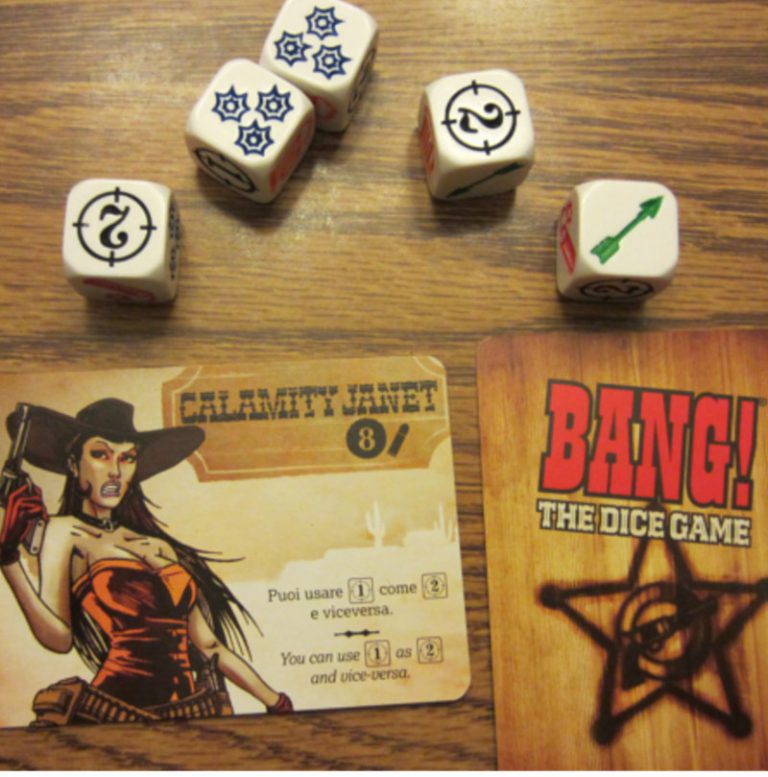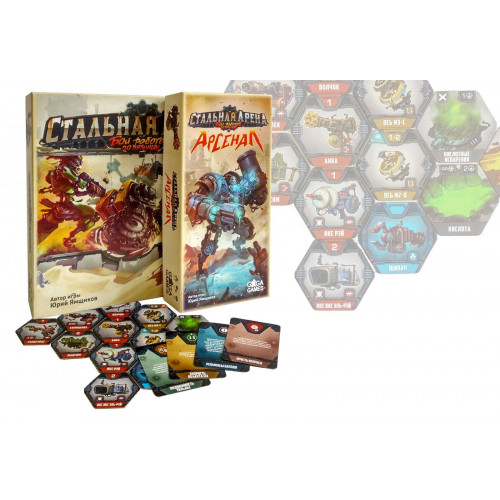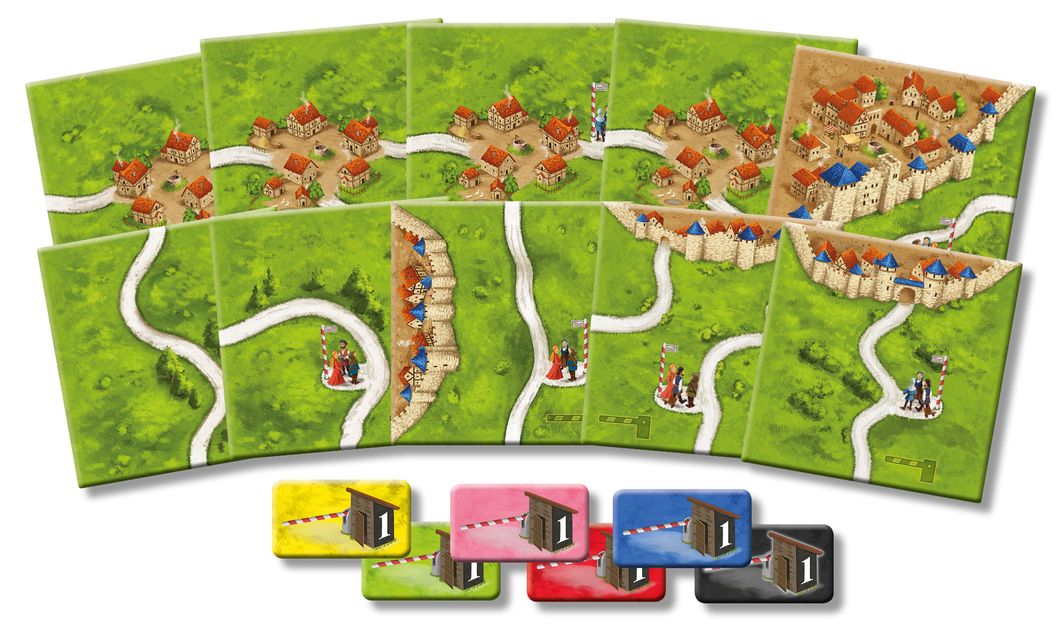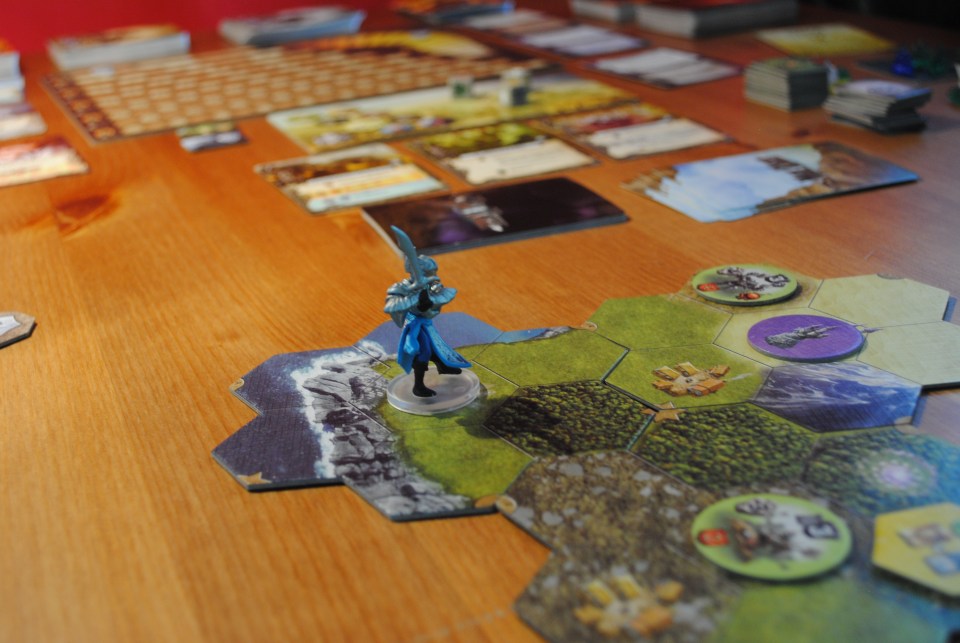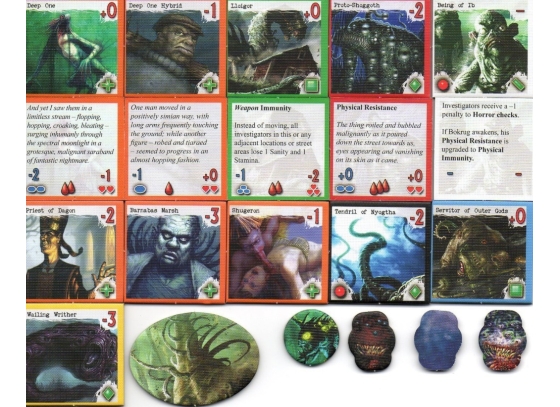The next Pokémon Go…
Private tech company Niantic just launched its next augmented reality (AR) game called Harry Potter: Wizards Unite… And it’s sure to be a megahit.
If you recall, Niantic is the company behind Pokémon Go – the AR game that launched in 2016. In a rolling 24-hour launch around the world, Pokémon Go was installed 7.5 million times. And it immediately became the highest revenue-generating application in U.S. app stores.
In fact, the response was so large, it took down the network. It was complete chaos for the first few days as Niantic scrambled to add computing resources to support consumer demand.
As the dust settled, Pokémon Go went on to generate nearly $2 billion in revenue over the next 24 months. And now, Niantic is at it again with Harry Potter: Wizards Unite.
It just launched the game on Sunday… but only in the U.S. and U.K.
This was smart given the massive demand expected. Niantic is gradually rolling out to the rest of the world this time. That will avoid the server crashes that plagued Pokémon Go’s launch.
Still, Harry Potter: Wizards Unite generated $300,000 on day one. And it rocketed to the top of U.S. app stores for most downloads.
So Niantic will put up incredible numbers once again. Harry Potter: Wizards Unite will become one of the most successful applications of all time…
And that proves that AR gaming is an extraordinary business.
Now think about this… Consumers are flocking to these AR games that run on smartphones. But smartphones are an awkward way to experience AR. You hunch over your phone… move it around… squint at the screen… It’s just not a great experience. Yet people are spending billions of dollars on it.
So what do we think will happen when the first consumer-grade AR glasses are launched?
AR glasses will make the AR experience seamless. No more hunching and squinting… You can play the game right in your line of sight as you walk around freely. That’s a game changer.
I’ve said it before… AR glasses are the next mass-market consumer frenzy. And they won’t be just for games.
AR glasses will do everything your smartphone does today… and much more. And it will do all of this in a seamless, natural way. These devices will ultimately replace the smartphone.
Gameplay
Each side is dealt a hand of seven cards. These can range from Event cards, ops cards, or campaign cards. Each player plays those cards to accomplish different tasks.
For example you can play an Ops card to place political control markers. The Ops cards also allow for activation of generals and this is where it gets interesting. American generals activate with a lower Ops cost than do the British. So the Americans can be much more nimble. Now on the flip side the British, when activated, tend to hit harder and move via the British fleet by sea.
So right off the bat both sides play totally different.
You can win by eliminating all the opposing armies, or by political control of the colonies. The British need to control 6, the Americans 7. In the case of a tie the British win by default.
At first it seems like you want to fight, but in reality it’s all about political control. Some states, like Rhode Island, only have a single space to control. Virginia has 11 spaces. So it’s much easier to control Rhode Island and Delaware than it is Virginia and Pennsylvania.
In order to flip a placed political marker you have to actually move an army onto it and play an ops card. (Or an event card that allows you to.) So now you have to move one of your armies about (which costs ops) and potentially send them out into the wilderness where the American army can pounce.
Once you play all of your cards you move into the winter attrition phase. The British, if in winter quarters, suffer no losses. However the Americans always suffer losses (except Washington’s Army). So that hard won American army dwindles in the frosts of winter.
Conclusion
The manual could have been better. GMT games manuals tend to be lacking white space. This one is definitely better than some, but still not great. The enclosed play aids are very helpful. Though I would have liked to have seen two more dice as it’s easy to forget rolls while looking up combat values.
Add in a really good Vassal module and a vibrant community that plays it and you’re likely to have no problem finding a willing opponent.
So in closing I heartily agree with @SpaceRumsfeld, aka Bruce Geryk. It’s one of those games that I think of when not playing and ponder different strategies. Not many games stick with me like that.
My First Game
Right off the bat my opponent (my sister) attacked General Howe in Boston with Washington’s Army. Both had 5 combat units. This was a very risky move. The British have a +1 advantage due to the British Regulars being active, and also another +1 for having the British Fleet as support. Howe and Washington are close to the same quality of general, but you roll and determine whether or not your general is having a good day.
General Howe wasn’t having a good day. He rolled a 1 so his combat rating was halved. This was followed by a roll of a 2 for overall combat effectiveness. Add in Washington’s luck, and the British were decisively defeated.
After that we rolled to see how many units the British would lose. You can lose up to a max of 3. In my case, that’s exactly what happened. This triggered a nasty side effect too, I lost my British Regulars advantage for the rest of the game. Ouch.
JPMorgan is finally focusing on digital banking services…
Word is out that JPMorgan is working on a secretive digital banking project in its London offices.
According to inside sources, the investment bank is recruiting high-level developers… But candidates must sign a nondisclosure agreement (NDA) just to get an interview. The NDA makes it illegal for them to talk about the project to anyone… even if they are not hired.
This level of secrecy is why JPMorgan is keeping the project out of Silicon Valley. It is trying hard to keep it under wraps.
The mainstream media says this is strategic. To me, this signals that JPMorgan is in panic mode.
Today, roughly two-thirds of Americans predominantly use digital and mobile services to do their banking. But JPMorgan completely missed this shift to online and mobile-first banking… because it was clueless about what consumers really want.
Consumers want competitive offerings and automated services. They don’t want to wait in line at a bank. They want to do banking from a simple interface, on either their phone or their laptop.
That’s why digital-first start-ups like Chime and Green Dot are tearing up the market. These are “banks” without branches… they are mobile banking only.
Chime has four million accounts, and it is still an early stage technology company. The company says its customers come from the big banks that consumers have lost trust in… like Wells Fargo.
And Green Dot has 6 million accounts as a public company. It did over $1 billion in revenue last year.
These start-ups have incumbents like JPMorgan scrambling…
Digital-first companies like Chime and Green Dot have pulled in millions of customers… But there are around 120 million people in the U.S. aged 18–50. That’s a huge market that will gradually migrate over to digital banking in the coming years.
Companies like Chime are the kinds of early stage companies I track closely, looking for an upcoming IPO. Chime delivers a great product with a great user experience and without all of the typical fees incumbents charge for the same services.
Financial services companies in particular are ripe for going public. Being a listed company, and filing quarterly financials, is one of the best ways for financial services to build additional trust in the market. Transparency is critical in the financial services industry. Chime would benefit greatly by making that final step as a company… and I’ll be watching closely.
Regards,
Jeff Brown
Editor, The Bleeding Edge
Mapping 2018 and Beyond
Let me repeat this mantra: once, almost seventeen years ago, there was one; now, the count is 76 and rising. Meanwhile, great cities have been turned into rubble; tens of millions of human beings have been displaced from their homes; refugees by the millions continue to cross borders, unsettling ever more lands; terror groups have become brand names across significant parts of the planet; and our American world continues to be militarized.
This should be thought of as an entirely new kind of perpetual global war. So take one more look at that map. Click on it and then enlarge it to consider the map in full-screen mode. It’s important to try to imagine what’s been happening visually, since we’re facing a new kind of disaster, a planetary militarization of a sort we’ve never truly seen before. No matter the “successes” in Washington’s war, ranging from that invasion of Afghanistan in 2001 to the taking of Baghdad in 2003 to the recent destruction of the Islamic State’s “caliphate” in Syria and Iraq (or most of it anyway, since at this moment American planes are still dropping bombs and firing missiles in parts of Syria), the conflicts only seem to morph and tumble on.
We are now in an era in which the US military is the leading edge — often the only edge — of what used to be called American “foreign policy” and the State Department is being radically downsized. American Special Operations forces were deployed to 149 countries in 2017 alone and the US has so many troops on so many bases in so many places on Earth that the Pentagon can’t even account for the whereabouts of 44,000 of them. There may, in fact, be no way to truly map all of this, though the Costs of War Project’s illustration is a triumph of what can be seen.
Looking into the future, let’s pray for one thing: that the folks at that project have plenty of stamina, since it’s a given that, in the Trump years (and possibly well beyond), the costs of war will only rise. The first Pentagon budget of the Trump era, passed with bipartisan unanimity by Congress and signed by the president, is a staggering $700 billion. Meanwhile, America’s leading military men and the president, while escalating the country’s conflicts from Niger to Yemen, Somalia to Afghanistan, seem eternally in search of yet more wars to launch.
Pointing to Russia, China, Iran, and North Korea, for instance, Marine Corps Commandant General Robert Neller recently told US troops in Norway to expect a “bigass fight” in the future, adding, “I hope I’m wrong, but there’s a war coming.” In December, National Security Adviser Lieutenant General H.R. McMaster similarly suggested that the possibility of a war (conceivably nuclear in nature) with Kim Jong-un’s North Korea was “increasing every day.” Meanwhile, in an administration packed with Iranophobes, President Trump seems to be preparing to tear up the Iran nuclear deal, possibly as early as this month.
In other words, in 2018 and beyond, maps of many creative kinds may be needed simply to begin to take in the latest in America’s wars. Consider, for instance, a recent report in the New York Times that about 2,000 employees of the Department of Homeland Security are already “deployed to more than 70 countries around the world,” largely to prevent terror attacks. And so it goes in the twenty-first century.
So welcome to 2018, another year of unending war, and while we’re on the subject, a small warning to our leaders: given the last 16 years, be careful what you wish for.
Put Fun First
My son loves all things active. Even on the basketball court he’s constantly in motion. The kid just has to move! He tires pretty quickly of repetitive tasks and, to some degree, wargames can feel that way with their prescribed turn sequences and deja vu moments.
The other thing that wargames have going for them is that they use dice. You can’t, as much as you might want, fudge the dice coming out of the tower on a critical roll for the child you’re teaching. Disappointment and heartache are part of gaming and being a good gamer across the table.
That means sometimes taking a break to clear your head. Get a drink of water, a snack, or just take some time to do something else for a little while. While Washington’s War is fairly short, there’s nothing wrong with breaking up the game into two or three sessions to keep the child interested.
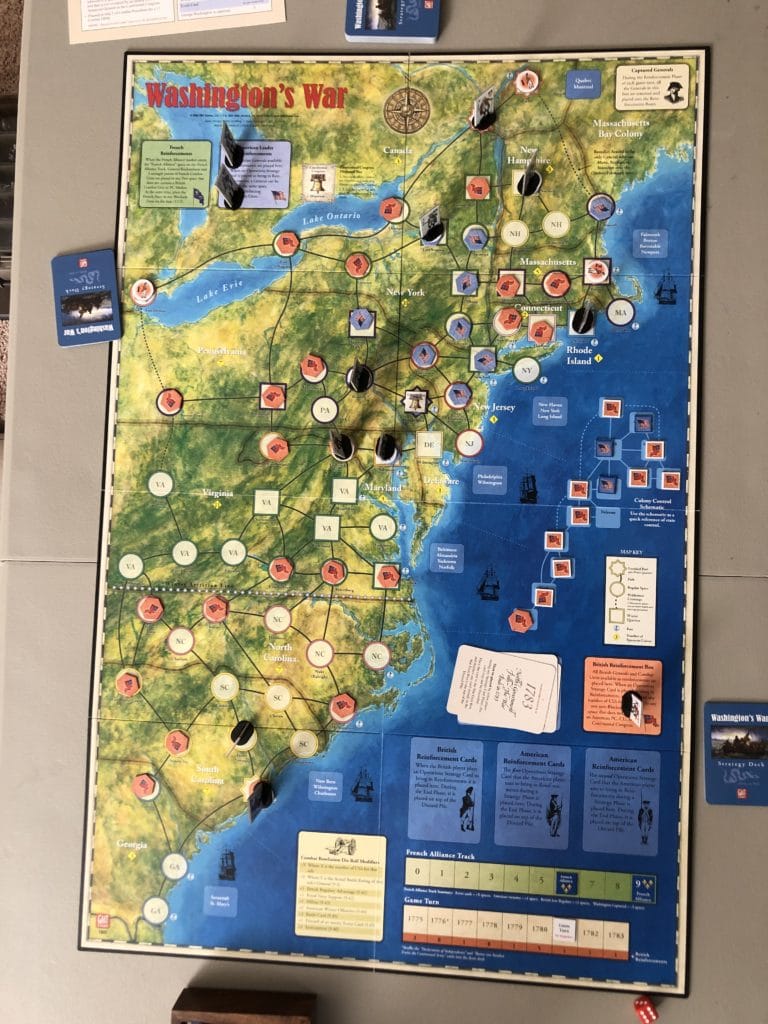
Putting fun first ALSO means celebrating great choices and positive outcomes. When Washington gets his first victory, high five it up! When the French join in on the side of the patriots…make french sounding noises. Use the milestones that mark success to reinforce the good feeling the child already has with tangible external encouragement! This is even easier if the child you’re teaching is your own.
Depth Over Time
Cover the rules for things like the French as they become more important. The child needs to understand why the French are valuable and how the French track works. That said, they don’t need to understand the nuance of French reinforcements, generals, and naval blockades just yet!

Give the depth of the game to the child over time. That’s done by talking through why you’re doing something. Reinforce the objective of the game repeatedly. It can be SO tempting for kids to want to get rid of that +1 British Regular advantage through combat early on when the British are sporting 20 CUs on the map and the Americans are squeaking by with like 6 or 7.
Instead, remind the child that the Americans need to retain their political power. Philadelphia is the heart of that power. Building PC networks that are adaptable and can link up, particularly along the coast, is hugely important for the Americans.
Children aren’t morons…usually
When my son started chess, I had no idea what to expect. He quickly advanced and learned the rules, strategies, and could talk-the-talk. He’s 10 and he’s easily my equal in chess (I’m not very good for my age and he’s very good for his having won a few local tournaments).
We don’t “talk chess” at my house. It’s his thing and we also don’t typically “talk wargaming” because that’s kinda my thing. Consequently, I was impressed by his thought process and in cases where I’ve played Euro-games with my son and his friends their thinking as well.
It can be easy to misinterpret being a child for being slower on the uptake with games and rules. Don’t fall into that trap. Kiddos are crazy smart and will surprise you with how cleverly they approach problems. Their willingness to take risks and their adaptability are unmatched.
Give the child credit and make every lesson additive to their knowledge. It can be easy to say “You should have done this!” Instead, flip that and ask, “What do you think might have happened if you had tried this instead?” Make THEM solve the problem.
Colonial Domination
After that the Americans decisively controlled New England and were able to deny me almost the entire center of the map. So instead I had to work with the South and incursions from Canada. Eventually the French were brought into the war as well and placed a very nasty blockade on me.
One very cool mechanic worth pointing out is the variable end date. Depending on the card, or lack of cards, the game could end in 1779, or 1783. This can be variable too, one round you think it’s 1780 and then your opponent plays the 1781 giving another year. What seems like a frantic drive to the end suddenly goes into overtime.
By the end I lost by two colonies. But it was damn close. Had I been able to flip just two more political control markers I would have won the game.
The game flowed quickly, was easy to pick up on, yet almost immediately we saw the potential for lots of different strategies.
Warning: Your Mileage May Vary
This is just a reminder that should go without saying. No two kids are alike. There are some universal teaching models and strategics (constructivist pedagogy) that will help you put your best foot forward. However, your mileage may vary!
My son is into chess. He is NOT typically into wargames. We have tried to play some games in the past and he’s just not into it. That’s 100% okay. I’d rather we find things to do together that we both like than me forcing him into my hobby. I’m 100% okay with him not having the same interests as much as I’d love that.
The time you spend across the table teaching a child to play is sacred. Whether it’s your child or another, you’re getting an opportunity to make an impression about our hobby that may last a lifetime even if the hobby doesn’t for them. You may end up being the only ambassador that the child ever has for our hobby and that’s a pretty cool responsibility.
Hopefully the information in this article will help you ease a child into Washington’s War and give you a framework for working with other games as you introduce them to kiddos!

My son decided we needed to play again … he wanted revenge as the Brits this time…
Teaching To Children
Start with the end in mind.
In this case, that means teaching what winning looks like for both the Americans AND the British. Learners, regardless of age need to know the expected outcome they are to achieve before diving into the rules. I’ve been explained a lot of games where 20 – 30 minutes into the rules discussion I still have no idea how to win.
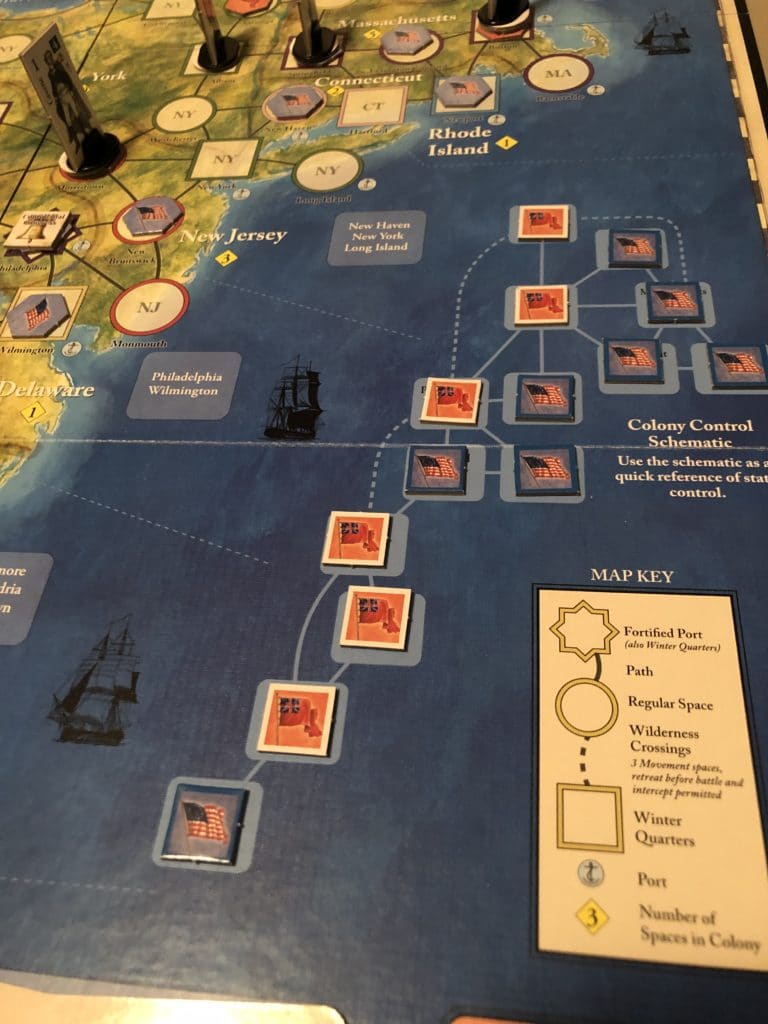
This little chart is life.
Be incremental
The jargony phrase here would be to “scaffold the instruction.” In effect, you need to sequence what you teach so that it builds up to the next concept and builds upon the last one covered.
Here’s a brief outline you can use with Washington’s War (Keep in mind this is NOT comprehensive and that’s a good thing…as you’ll see in a moment)
- Teach the objective of the game for both sides.
- Show the political control markers and then have the child practice making legal placements and seeing their options.
- Teach the abbreviation of PC for these markers and teach isolation. Have the child set up an isolation.
- Introduce Generals and talk about who they were and what generals did for armies historically. (The context here is important because it helps explain their features and some of the rules)
- Teach children about combat units and their abbreviation (CU’s).\
- Run through a made up sample combat and remind them that the goal is not necessarily to defeat your opponent militarily. That’s only a means to an end.
- Talk through the various roll modifiers and teach the abbreviation of drm. Again, the history here will help a little.
- Teach the child about the Continental Congress and what it means if the British disperse the Continental Congress.
- Show the various card types and talk through each with the child:
- War End Date Card
- British & American combat strategy card
- British & American event strategy card
- Take some time to go through the deck and explain some of these cards and what the implications might be when played. Then randomly place some PCs on the board and let the child work through some of the event cards and re-fight a battle so you can keep them rolling dice and engaged.
- Show the child the 1,2, & 3 Ops cards and talk through the options one at a time, letting the child actually do the task.
- Talk about playing an opponent’s event strategy card as a 1 PC with limits action.
- Talk through how a turn works and show them how the charts on the board and their player aid card are all laid out so they can refer to them when needed.
- Go through the game setup with the child taking the Americans so they can control General Washington and place the Committees of Correspondence. Make the child talk through their logic and help them see their options while respecting their choices. This shouldn’t be aided solo-play!!!!
- Talk through the turn sequence and remind them how all the pieces you’ve covered fit together.
Questions, Questions, Questions
You can take the next step in a variety of ways. A lot depends on how the child you’re teaching has responded to the information you’ve shared to this point. I advocate playing with an open hand for the first turn so you can talk through what you’re thinking and how you will use your cards just as you should encourage the child to do so.
This gives them the opportunity to see and understand the logic.
Ask LOTS of questions of the child as they play to help them gain confidence. Here were a few I asked repeatedly?
- What do you (American player child) ask me as the British player at the start of each turn?
- What happens if this general doesn’t end its turn in Winter Quarters?
- Why do you want to fight in ports when you’re the British?
- Why are you placing the PC marker there instead of somewhere else?
- A 3 Ops card is a big deal, talk me through why you’re using it that way!
The questions are intended to have the child express their thinking and logic. You need to be overwhelmingly supportive of their choices while also gently giving some things to consider. Remember, as the adult, the child you’re teaching is going to value your input perhaps more highly than their own which might overly influence what they’re doing. Instead of teaching the child, you’re effectively playing for them and that’s not going to be any fun for the kiddo. Praise the good choices and let the questionable ones stand as-is as long as there’s logic behind it.
Washington’s war on “deepfakes”…
We have talked about how artificial intelligence (AI) can now create fake videos… fake speeches… even clone voices… And Washington is now catching on to this severe threat to democracy.
The House of Representatives just proposed the “Deep Fakes Accountability Act.” This bill, coded H.R. 3230, would require anyone who creates media portraying a real person to disclose whether it is real or fake.
In other words, media created by an AI would have to be labeled as such. And the bill even suggests using digital watermarks to verify media… which is something we talked about before also.
If passed, the penalty for violating this bill would be a steep fine and up to five years in prison.
It is great to see that Congress has recognized how serious an issue this is. And I’m happy to see how early Congress is tackling it. After all, this technology has just evolved as a major threat earlier this year.
The ethical questions mankind will face in the next decade will be unprecedented. There is no historical example of what we are going to face.
As a technologist, I believe that technology has always been a force for good. And I believe technology will continue to solve society’s biggest problems in the years ahead.
But we are at an inflection point. Over the next two decades, either our society will become one of abundance for all… or it will descend into chaos.
I am definitely in the camp that has an optimistic view of the future.


